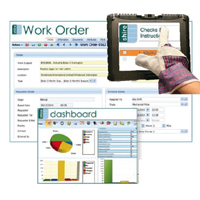 Planned Preventative Maintenance, A Paradox
Planned Preventative Maintenance, A Paradox
Planned Preventative Maintenance, or PPM, is a paradox, because it involves doing work in order to avoid doing work.
Not that it can’t be justified. You may choose to get the car serviced regularly, or not, in which case it will suffer an eventual breakdown, (Read More)
which will be both more expensive and more inconvenient than keeping it serviced. The parallel with manufacturing is clear: PPM can reduce breakdowns and so prevent expensive production losses, as well as extending asset life.
Advertisement - Hover to see more
Advertisement - Hover to see more
But PPM has a downside. It is expensive; and maintenance tends to be the poor relation when it comes to the allocation of departmental budgets. (Maintenance seems to offer no return on investment: yet in truth, it offers a hidden ROI in the form of reduced production losses.) It is wasteful: the work is done because it is due, without knowing if each step is specifically necessary. It requires heavy use of parts. It is also work-intensive. Why set up a comprehensive PPM regime, only to find that the resulting volume of scheduled work is overwhelming? In this situation, the paradox comes home to roost.
Resolving the PPM paradox is central to maintenance strategy. Some suggestions follow.
If there is insufficient labour, PPM work may pile up. But reports from the CMMS (Computerised Maintenance Management System) may at least provide evidence of the need for more labour.
A simple optimisation technique is to stretch out frequencies. The manufacturer’s recommendations are not holy: they want to play safe, and sell you parts. So, regulatory, warranty, or other constraints aside, can the frequency be stretched, without significant increased risk of breakdown? This is an engineering judgement.
A CMMS will commonly invoke minor job suppression where jobs of different frequencies, say 12M and 6M, happen to coincide, or occur close together. The element of redundancy in PPM can be made much worse if this doesn’t work, or is poorly configured. If suppression thresholds are too tight, some minor jobs get carried out unnecessarily, and nobody notices. A job should be suppressed whenever its proximity to a major job is within half its own frequency.
You probably service your car, not by the calendar, but by miles driven. The move to a meter-based schedule does involve the overhead of recording meter readings; but it can also prevent premature services following periods of light use.
A particular machine can be well cared for and still be a lemon. On Pareto’s 80-20 rule, a minority of assets will take up a majority of the maintenance effort. It is important to identify the worst assets and either deal with the root causes of the trouble, or replace them.
Certain items are not serviced, but inspected; a discharged fire extinguisher, for example, is simply replaced or recycled. But inspection can partially displace equipment servicing. Instead of replacing a component, perhaps it could be inspected to determine its condition. Different kinds of components follow different patterns of failure, but in general, lifetimes are unpredictable. It makes sense to let a robust component run on, and to anticipate premature failures that a rigid replacement plan would miss.
Condition-based monitoring involves taking readings of parameters such as temperature or vibration. This represents an ideal strategy whereby failures are picked up before they happen: hence the alternative name of predictive maintenance.
It can be of great benefit to get machine operators to carry out visual inspections, cleaning, lubrication, or simple parts changes. (The other side of the coin is that error-prone operators can increase the reactive workload.) This strategy is sometimes called autonomous or operational maintenance.
Maintenance work and stores control can be handled more directly and efficiently with handheld devices, as this cuts out paper and reduces the need for CMMS operators. The use of barcodes or RFID tags makes it even better. Though many industrial sites have a poor wireless signal, off-line solutions are available to handle this.
Resolving the Paradox – a Checklist
- Can I produce evidence of the case for recruitment?
- Can any servicing frequencies be safely lengthened?
- Is minor job suppression working, with none slipping through?
- Should any calendar-based PPM be moved to meter-based (or combined) schedules?
- Can I identify and deal with my most unreliable assets?
- Is there any scope for reducing the servicing element and increasing inspections?
- Is there a place for condition-based monitoring?
- Could the operators take on some of the simpler maintenance tasks?
- Could I be using handheld devices and barcodes to process work orders and stock transactions?
Shire Systems has designed and delivered low cost, best value maintenance and asset management solutions since 1982
Shire Systems Limited
www.shiresystems.com
Telephone +44 (0)23 8022 4111
E-mail This email address is being protected from spambots. You need JavaScript enabled to view it.



